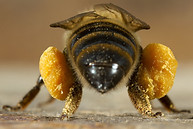

Solitary Bees
When you think of bees your mind probably goes straight to yellow and black striped bees living in a hive with a queen and producing honey. However, only ten out of the ±1,300 bee species in South Africa actually produce honey!
The vast majority of our bees (and bees worldwide) are actually Solitary bees. These bees do not live in hives or large colonies, they do not serve a queen and they are very unlikely to be aggressive or sting. Solitary bees are extremely important and efficient pollinators in our agricultural, natural and urban landscapes.
The female bees build small nests in burrows or cavities and inhabit them alone. The nests are separated into several chambers, which are each filled with nectar and pollen collected from the surrounding vegetation. The female lays one egg in each chamber and then seals off the nest. When the eggs hatch, the larvae will feed on the nectar and pollen in their chambers. They remain there until they reach adulthood, and it is time to leave the nest for mating.
The cycle is then repeated.
Common types of Solitary bees to expect in your bee hotels

Leafcutter bee
Family: Megachilidae
Leafcutter bees cut leaves into small semi-circular shapes and carry these leaf pieces to their nest where they are used to separate the brooding chambers and to seal off the nest. Another interesting characteristic is that they carry pollen on the bottom of their abdomen, making them efficient pollinators.

Carder bee
Family: Megachilidae
Carder bees can use resin, plant fibres and earth to build their nests. They use these materials to create the nest walls, and to separate their brooding chambers. Carder bees are robust.

Allodapula bee
Family: Apidae
A semi-social bee that can often be found in the 4mm holes of the bee hotel. They do not seal off their nest but rather they block the hole with their rear ends. The female bee lays her eggs in the nest and then actually stays with and looks after her offspring. A returning bee, laden with pollen, is often faced with a bum blocked door, she touches it with her antenna and like magic the door slides open. They carry pollen on their legs like a honey bee.

Hymenoptera fg01 20060826 Schwanheimer Dueneby Fritz Geller-Grimm (CC BY-SA 2.5))
Membrane/ Plasterer bee
Family: Colletidae
Membrane bees use secretions from their mouthparts that resemble cellophane to seal off their nests. It takes them a few hours to completely seal the opening of their nest. Some subspecies collect pollen in their crop and regurgitate liquid/ semi-liquid pollen while other subspecies carry pollen in external structures.
Text and photos: Peter Webb (Tutus Loco) and Candide
Taxonomy and Importance of Bees
Worldwide, there are an estimated 30,000 bee species that make up the superfamily, Apoidea. This supergroup consists of seven families of bees, six of which can be found in South Africa, that are classified as either short-tongued bees or long-tongues bees.
Short-tongued bees include the Colletidae (Cellophane bee, Membrane bee etc), Andrenidae (Sand bee, Shaggy bee etc), Halictidae (Ground bee, Sweat bee etc) and Melittidae (Trouser bee etc) families.
Long-tongued bees include the Megachilidae (Carder bee, Leafcutter bee, Resin bee etc) and Apidae (Honey bee, Carpenter bee etc) families.
The biology and behaviour of bee varieties differ greatly between and within the different families. However the main and most important similarity between all bee species is that they feed their larvae (babies) with pollen. This explains why bees (both commercial Honey bees and wild bees) are considered to be the most important pollinator group. Unlike most other pollinators, bees are intentionally collecting pollen to take back to their nests and during this process they spread pollen between flowers of the same species.
However, the manner and efficiency of how bees carry this pollen varies between species. Female bees do most of the pollen gathering and they have evolved very specialised mechanisms for effectively carrying this pollen.
Honey bees carry pollen in baskets formed by their hairs; certain Solitary bees have long and sticky legs that are slightly positively charged to attract negatively charged pollen grains; Solitary bees in the Megachilidae family store and transport pollen in long hairs on their abdomen (stomach); a few bee species actually carry the pollen internally in specialised organs!


© 2016 Jatai

Heidi&Hans-Juergen Koch/Minden Pictures
Click on this interactive phylogenetic tree to see which bee species fall into each family!
The seven families and their evolutionary relationships are portrayed in the above phylogeny. The bee hotels will only attract bee species from the four purple families (Stenotrididae bees are not found in South Africa) and some species in the Halictidae family.
Honey bees are the most well known bee, so much so that people often use the term "bee" as interchangeable with "Honey bee", disregarding the other bee species. This family tree displays that Honey bees (a variety in the Apidae family) is only one species in the midst of thousands. They are of course invaluable to ecosystems and to our food security but it is important to be aware of the huge diversity within the bee superfamily!

